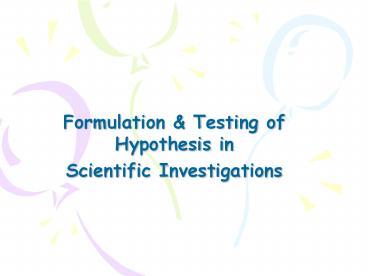Formulation - PowerPoint PPT Presentation
1 / 25
Title: Formulation
1
- Formulation Testing of Hypothesis in
- Scientific Investigations
2
What is a hypothesis?
- Posing a question
- ?
- Proposing a hypothesis
- A tentative explanation
3
Why need a hypothesis?
If the hypothesis is correct, what predictions
can be made? ? Design experiments or plan
observations.
4
- If the hypothesis is correct, we should observe
xxx when a certain test is conducted
predictions - ?
- This guides us to plan observations or design
experiments
5
- A question that asks why usually requires a
hypothesis. - A question that asks what is the relationship /
how to be affected usually requires making
objective observations. ? - No hypothesis is needed.
6
What hypothesis should be put forward for the
following investigations?
????????????????
????????????????
7
?????????????
8
?????????????
9
Do we need to suggest a hypothesis for the
following questions?
- What is the W.P. of potato cells?
- Why does a potato become more soft after storing
for a long time?
10
Do we need to suggest a hypothesis for the
following questions?
- What is the optimum temperature for salivary
amylase? - Why is salivary amylase still very active at 70oC?
11
Do we need to suggest a hypothesis for the
following questions?
- What is the effect of light intensity on the rate
of photosynthesis? - Why does the rate of photosynthesis becomes
constant with increase in light intensity when
the light intensity is high?
12
What food constituents are present in peanut,
banana, grape, potato and biscuit?
- Hypothesis
- I think that peanut, banana, grape, potato and
biscuit all have proteins and lipids.
13
What is the respiration rate of mealworms?
- Hypothesis
- I think that the respiration rate (oxygen uptake)
is constant.
14
What is the transpiration rate of a plant outside
and inside the laboratory?
- Hypothesis
- The plant outside the lab should have a higher
transpiration rate than the plant inside the lab.
15
What is the effect of light intensity on the rate
of photosynthesis?
- Hypothesis
- The photosynthetic rate rises with increase in
light intensity.
16
What is the osmotic potential of the cell sap in
red onion epidermal cells?
- Hypothesis
- When 50 of the observed cells is plasmolysed,
the O.P. of the cells is the same as that of the
surrounding sucrose solution.
17
In the Coleus leaf, more stomata are present on
the lower epidermis than on the upper epidermis.
What is the significance of this uneven
distribution of stomata?
- Hypothesis
- To reduce the rate of water loss due to
transpiration when sunlight shines directly from
above. - To allow a faster rate of photosynthesis as more
carbon dioxide can be taken in.
18
If a potted plant is placed outside the
laboratory for two days without any water supply,
it becomes wilted. A similar plant inside the
laboratory will not show wilting. How would you
explain these observations?
- Hypothesis
- The plant outside the laboratory becomes wilted
because it has a higher transpiration rate due to
the windy conditions outside. - The plant outside the laboratory becomes wilted
because it is hotter outside.
19
Potatoes stored for a long time becomes soft to
the touch. Why does this occur?
- Hypothesis
- The longer the time of storage, the more water is
lost through transpiration. - The cell membrane is damaged during storage. So
the cells lose their turgidity.
20
- Posing a question (Why ?)
- ?
- Proposing a hypothesis
- A tentative explanation
A tentative idea that generates predictions for
testing the idea.
21
Posing an investigatable question
?
Is it necessary to put forward a hypothesis ?
?
Designing experiment/observation
22
Designing experiment/observation
Biological principle
?
Designing method of investigation
?
What is the independent variable?How to change
it?
?
What is the dependent variable?How to measure
it?What are the assumptions made?
23
Designing experiment/observation
What are the controlled variables?Any
assumptions made?
Is it necessary to set up a control
experiment?If yes, how to do it?
24
What are the assumptions that you need to make in
order to draw a valid conclusion from your
results?
To measure transpiration rate using a bubble
potometerrate of water absorption rate of
transpiration
To find the W.P. using the change in mass
methodchange in mass of potato cylinder ?
amount of water uptake/loss by osmosis
To find the growth rate of a plant by measuring
the change in dry masschange in dry mass ?
amount of cytoplasm formed
To compare the sugar content of green, red and
dark grapes using Benedicts testamount of
reducing sugar ? total amount of sugar
25
Assumptions made in the controlled variables?
Effect of light intensity on photosynthesisrate
of respiration remains constant in different
light intensity gas bubbles are identical in
size
To compare the vitamin C content of different
food samples using DCPIPEach drop of solution
has the same volume the end points are the same
To compare the rate of anaerobic respiration of
yeast using different substratesair temperature
pressure unchanged the yeast samples are
identical































